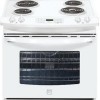Kenmore 4558 Use and Care Guide - Page 21
General, & Cleaning
 |
View all Kenmore 4558 manuals
Add to My Manuals
Save this manual to your list of manuals |
Page 21 highlights
General Care & Cleaning (cont'd) Models with Coil Surface Elements Porcelain Enamel Cooktop Cleaning Instructions Do not use a cooktop cleaner on a hot cooktop. The fumes can be hazardous to your health, and can chemically damage the cooking surface. Before cleaning the surface cooktop, be sure the controls are turned to OFF and the cooktop is cool. DO NOT use commercial oven cleaners on the exterior surfaces including rangetop and door frame. Correct and consistent cleaning is essential to maintaining your porcelain enamel cooktop. If food spills and grease spatters are not removed, they may burn onto the surface of the cooktop and cause permanent discoloration. Daily Cleaning For normal soil: 1. Allow cooktop surface to cool. 2. Wipe off spills and spatters using a clean paper towel or a clean cloth with warm, soapy water. 3. If needed, use a non-abrasive plastic type no-scratch pad or other mild household cleaners. 4. Be sure to rinse off the cleaners or the porcelain may become damaged during future heating. For heavy, burned-on soil: 1. Allow cooktop surface to cool. . Use a soap filled scouring pad with warm water or cover heavily soiled spots with a solution of clear water and ammonia. Scour gently. Rinse and wipe dry with a clean cloth. . If any soil remains, apply a few drops of a recommended cooktop cleaning cream on the spots and rub gently using a i' clean damp cloth or scouring pad. Buff with a dry cloth until all soil and cream are removed. Frequent cleaning with the cooktop cleaning cream leaves a protective coating which helps in preventing scratches and abrasions. For sugary spillovers: Sugary spills can chemically damage your cooktop surface. Therefore, you must begin cleaning the spills while the cooktop is still hot. Use caution when following the steps below. 1. Turn off all surface units and remove all pans immediately. 2. Put on an oven mitt, wipe up carefully or move hot spills away from the element area with a clean damp cloth. 3. Allow the cooktop to cool. Follow the instructions above for heavy, burned-on soil. Coil Surface Element To Remove and Replace Surface Elements and Drip Bowls ATTENTION: Never leave lids on the coil elements as they could be permanently damaged ifthe coil is turned on by accident. Prior to cleaning the drip bowls make sure the coil elements are cold and the control knobs are turned to OFF Coil elements clean themselves when they are turned on. Coil elements and drip bowls are removable and allow you to clean the drip bowls. To remove a coil element, push against the front edge and lift element up and out. To clean by hand, wash the drip bowls in hot sudsy water. For hard to remove spots, use nylon scrubber with soap. Rinse and dry while still warm. \"X ",,\. "\ Never immerse coil elements in water. Be careful not to bend terminal ends when replacing elements after cleaning. 21















